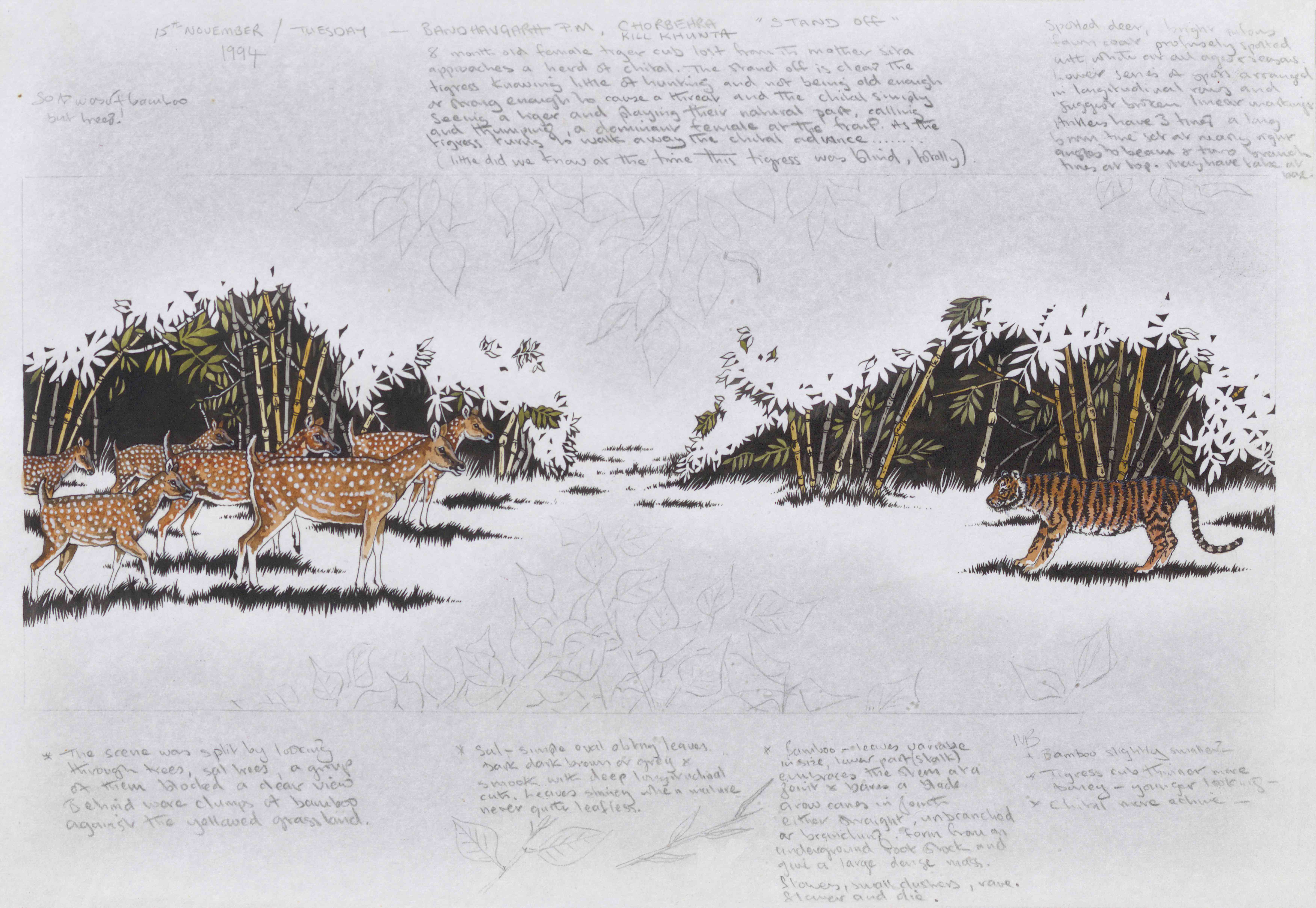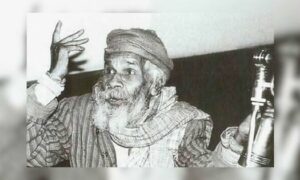How does blindness in a big cat get detected? How does a tiger mom respond to dangers that the forest and tourism pose to a very special cub? This fascinating, true story from the Bandhavgarh National Park and Tiger Reserve has been penned by Kay Hassall Tiwari, a long-time resident of Tala village in Bandhavgarh.
Kay is an exceptional artist who has drawn and painted tigers and landscapes for some three decades there. Her Bandhavgarh oeuvre of drawings has appeared in books. What makes this story a singular one is that she has combined sketches with words to tell a little-known tale of Sita and her blind cub in Bandhavgarh.
Sita was a famous tigress, perhaps the most famous one to have graced the jungles there, and Kay has often described her as the matriarch of the forest. Sita’s maternal instincts towards her litter shine through the story as does the pathos and helplessness of her cub.
In 1994-1995, the use of elephants for tourists was banned in Bandhavgarh and Madhya Pradesh. As a result, tiger sightings dropped considerably. The ban was to be lifted later in the season as complaints poured in and income from tourism dropped.
Sita, the dominant tigress of Tala, was moving with a new litter fathered by Charger. It was thought that she had three young cubs, approximately six months old. Sita, incidentally, was the most beautiful of tigresses, calm and tolerant and sublimely graceful. She had been born to tourism and rarely showed aggression.
On one of my first visits to the park in November 1994, my husband Satyendra and I and a couple of guests had gone out specifically to look for this family. Sita had a huge territory covering half of the tourism zone of the Tala Range from the Chakradhara meadow and the Bandhavgarh fort hill in the heart of her territory, down to Thauni in the west and up into the hills of Ghorademon and Khirki to the east.
Since there were few visitors to this remote park, tourists were free to go wherever they wanted. We tracked Sita into the hills around Ghorademon. The beauty of the park in those early days was that you could learn how to track and develop skills even without seeing a tiger. It was exhilarating and made the process of seeing a tiger that much more rewarding because the skills of the guide and naturalist had made that dream of seeing a wild tiger come true.
We heard the alarm calls of sambar amongst the rocks and within minutes caught glimpses of Sita and her two cubs moving quickly. Satyendra, being aware of the route they might take, knew where we could intercept their path. As we approached the spot, we saw Sita and one cub vanish into thick cover. We drove slowly down the track when the second cub came on to the road and walked directly towards us. Satyendra quickly stopped, hoping the cub’s inquisitiveness might cause it to either sit on the road or continue to move forward. However, to our surprise, as soon as the sound of the engine stopped, the cub turned and walked away but when we started the engine motor, the cub again approached us.
At that time we did not give this behaviour much thought. It was only later discovered that the cub was blind. This accounted for the fact that its guiding force was sound and also why it would approach without fear a large vehicle – in this case, a 1987 Maruti Gypsy. Obviously, following its mother was a problem and if the cub could not stay close to her and hear her calls, it often strayed away from her path.
After that, we saw this cub on several occasions but rarely saw Sita or the second female cub. Till the age of six months, the mother usually takes the kill to her cubs, but after that a cub moves with its mother from kill to kill. The blind cub would often get lost. I remember two specific occasions.
Once, Satyendra, some guests and I saw the blind cub approaching a herd of chital grazing in a small clearing. The chital gave alarm calls but the young cub continued to approach them. The chital, suspecting something odd or believing that a young cub could pose no danger to them, did not run and some even continued to graze. As the chital stopped calling, the cub wandered off into the forest and disappeared from view.
Satyendra and I began suspecting that there was something strange about the cub, but because its eyes appeared clear and normal, we doubted it could be blind.

The second instance was a few days later when the cub had wandered into the village of Garhpuri and then a house there. Being alone after losing its mother and attracted by the sounds of the village during the night, it went there and found itself in an awkward situation. Elephants were sent to retrieve it and though it happily followed them, they could not persuade it to leave and return to the forest. After considerable effort, the cub was left there and eventually Sita found her.
After this incident, the park authorities monitored the cub and noticed that when Sita brought food, the blind cub’s sibling would steal the whole meal. Being blind, the cub had trouble locating even the smallest of morsels. The park authorities still had no idea that the cub was blind but found out some days later when it was in a weakened state and they took food and water for it.
As Kuttapan the head mahavat got down from his elephant, Sita and her healthy cub looked on. Kuttapan was able to walk straight up to the blind cub and feed it. The park authorities were now faced with a huge problem: whether to leave the cub to die or remove it to captivity.
Monitoring and feeding continued but the blind cub failed to do better and often got separated from its mother and sister. Sita too was becoming more and more stressed by the condition of her cub and the constant presence of elephants and people. One fateful day in early December 1994, Satyendra and I, accompanied by a frequent guest of ours, found the cub crippled and crying in the middle of the road approaching Chakradhara meadow.
We were joined seconds later by another vehicle, which pulled up parallel to us on our right. It was pitiful to see the cub was visibly in great distress. Satyendra and I immediately went back to the gate and told the park authorities about the situation and then returned to the cub’s location to await their arrival. All seemed calm but we found the cub still lying on the road crying. Satyendra’s thoughts drifted to Sita. He suggested that the cub’s mother must be looking for her and perhaps hearing its call. She could be close by and we should be aware of that.
Satyendra had barely finished this sentence when there was a tremendous roar and in a split second, the tigress almost flew out from the trees to our left and charged at our jeep. It was frightening – this was a real and the only really threatening charge that I had ever witnessed. Sita was distressed and concerned. She charged at the vehicle three times. Satyendra stood up and yelled back as she roared in rage, and in our efforts to back out from her range, the two vehicles got entangled. One of the occupants of the other jeep was terrified as the vehicle had no doors and insisted that we stay at its side.
Eventually, we were able to get out of Sita’s view. We left the area believing it better to leave the cub in Sita’s care rather than interfere further. It was clear to us that she was desperately trying to protect her cub and no matter what anyone did, their presence would mark the tigress forever. She was becoming intolerant of human presence.
One can never predict an animal’s behaviour but one can learn from it and both Satyendra and I had learnt a great deal from this incident.

Unfortunately, that night the blind cub died. It may have been too badly injured to survive or it may have choked on the food left for it by the forest department. Being blind was a death sentence in the wild and the cub’s only chance would have been life in a zoo. Possibly a death in the wild after such a struggle was better, perhaps even a blessing.
For Sita, this was a huge turning point in her life. The forest department removed the cub’s body before Sita had a chance to take in that the cub was dead. Perhaps she never saw it dead at all. For five days after this event, every afternoon at a specific time, Sita would walk through the meadow where she had last seen the cub and call. She was calling for her cub little knowing it was dead and gone. She would glance steely-eyed in the direction of the vehicles and continue walking.
After this Sita never treated jeeps with the same tolerance she once had. She suspected that they were responsible for her cub’s disappearance. Sita took her remaining cub deep into the forest and was hardly ever seen for the rest of the season but for rare glimpses in the grassland.
Kay Hassall Tiwari has been fascinated with animals and nature since she was a child in England and has been painting them from then till now in Bandhavgarh, where she now lives – a perfect place for observing tigers and habitats.
This article first appeared on Scroll.in
📰 Crime Today News is proudly sponsored by DRYFRUIT & CO – A Brand by eFabby Global LLC
Design & Developed by Yes Mom Hosting






